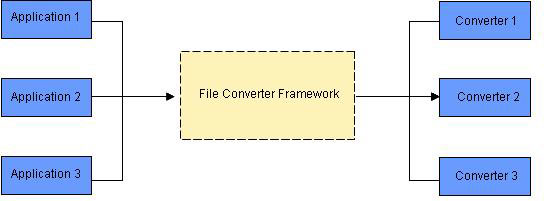Overview
Purpose
The File Converter Framework converts data from one format to another format. For example, HTML files can be converted to Symbian word documents.
Architecture
The File Converter Framework architecture provides a framework for ECOM plug-ins, called converters, that can convert data between different formats. When an application requests to convert data from one format to another format, the framework checks the list of available converters. If there is a converter that can do the conversion, then the framework assigns the request to that converter.
The following diagram shows the File converter framework architecture.
API summary
| API | Description |
|---|---|
|
A class that contains the properties of a converter. These are a UID and the data types that the converter supports. |
|
|
A class that provides an interface to access the converters. |
|
|
A base class for converters. |
|
|
A class that provides a list of available converters. It allows clients to search for and obtain converters for specific source and target data types. |
|
|
A class that encapsulates a collection of converter properties, CCnaConverter , read from a converter information .rsc file. |
|
|
A class that contains the localized names for a data type. |
|
|
An interface implemented by the client of a conversion operation to observe conversion progress. |
Typical uses
Using a converter
File Converter Framework provides APIs to list and search for converters. It also provides an observer interface through which the progress and success or failure of the conversion can be reported. For more information, see Using a converter .
Writing a converter
File Converter Framework specifies a plug-in interface for converters. For more information, see Writing a Converter .
Copyright ©2010 Nokia Corporation and/or its subsidiary(-ies).
All rights
reserved. Unless otherwise stated, these materials are provided under the terms of the Eclipse Public License
v1.0.
